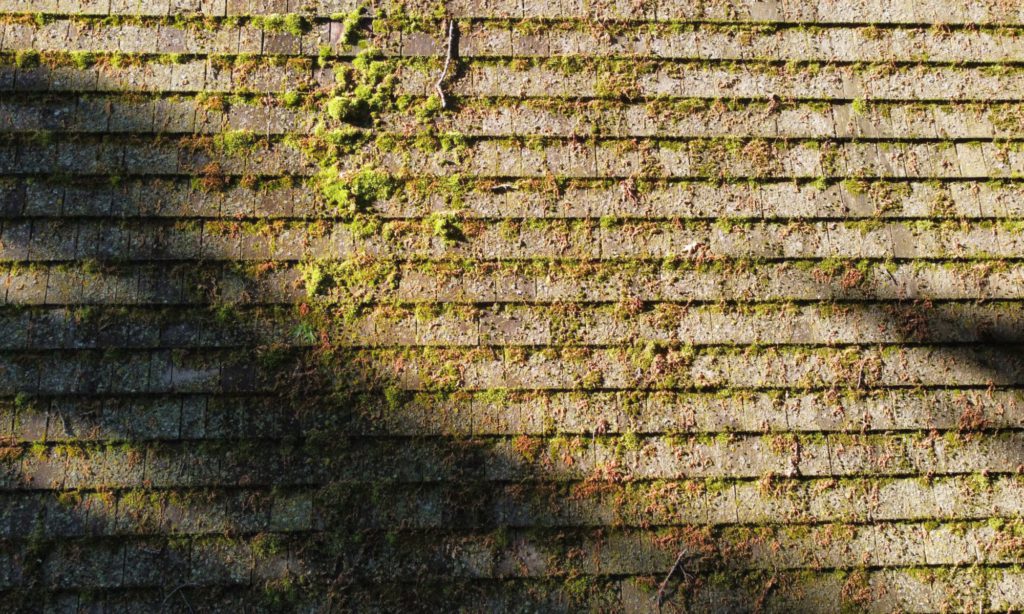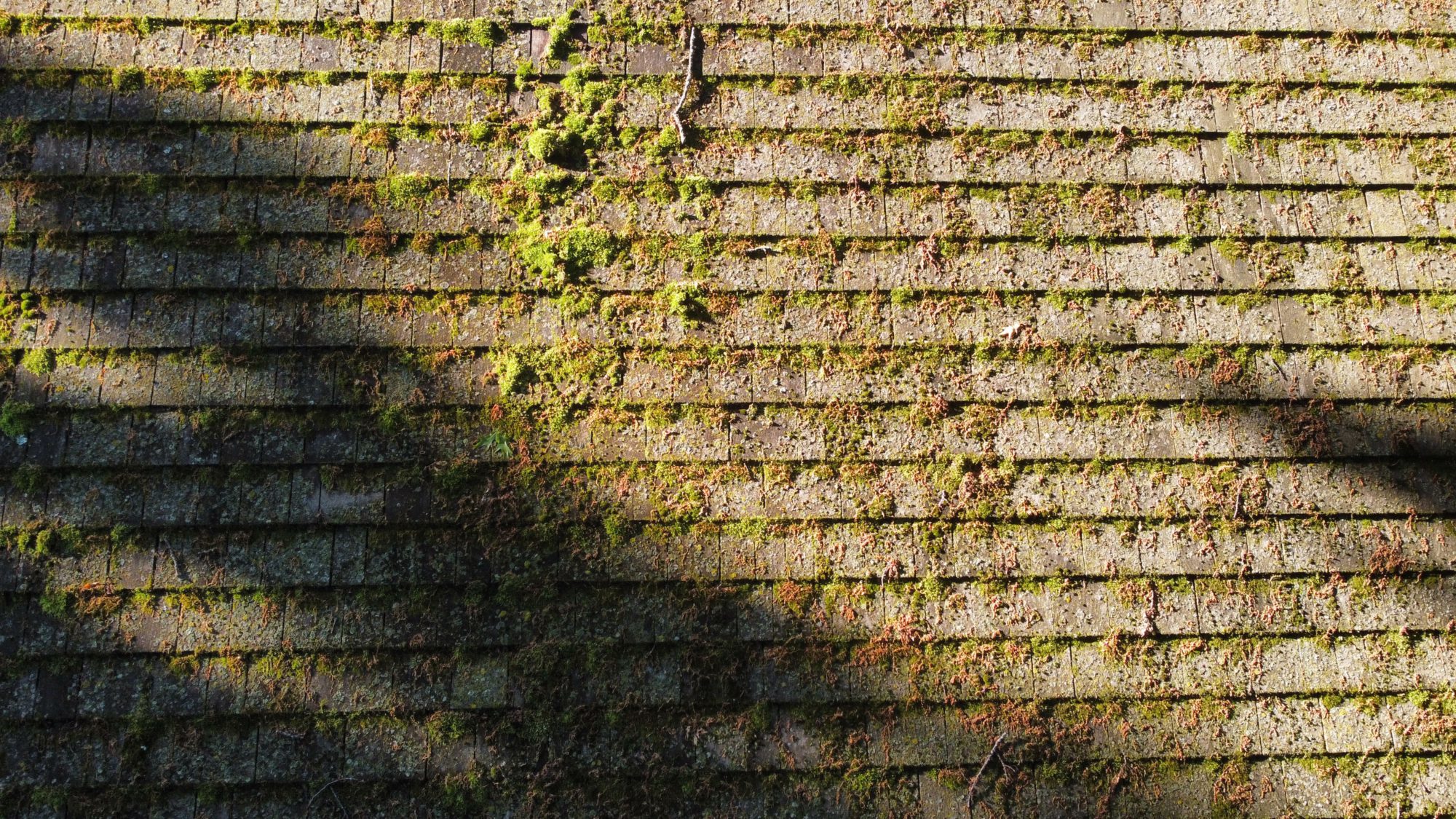What Is Moss and Why It Grows on Structures
Moss is a non-vascular plant that reproduces via spores and thrives in moist, shaded environments. Unlike weeds or vines, it doesn’t need soil to root. This ability allows it to grow directly on roofs, concrete, and wood. Moss tends to develop where there’s little sunlight, plenty of moisture, and minimal air circulation — making roofs and shaded walkways ideal breeding grounds.
As it grows, it forms a thick mat that can trap even more moisture underneath. And while moss might seem harmless at first glance, it’s precisely this moisture retention that leads to structural issues.
Moss on Roofs and Structures
Beneath its soft, velvety green surface, moss poses a persistent threat to the integrity of homes and buildings. It may look picturesque clinging to rooftops or nestled in the crevices of stone paths, but don’t let its fairy-tale appearance fool you. Moss is not just a cosmetic issue—it is a living, growing danger that can damage your structure from the top down.

Why Moss Loves Roofs
Roofs — especially older or shaded ones — offer moss the perfect home. Asphalt and wood shingles, in particular, provide the texture and porosity moss needs to anchor its root-like structures. The north side of a roof often receives the least amount of sunlight, remaining damp and cool — ideal conditions for moss.
Moreover, roofing materials can accumulate organic debris such as leaves or pine needles, which decompose into a moist, nutrient-rich layer where moss can easily flourish.
How Moss Affects Roof Shingles
Moss isn’t content with merely resting on your shingles — it digs in. The moss’s rhizoids penetrate into the tiny crevices of your shingles. Over time, this constant infiltration can force the shingles apart. Once lifted or cracked, shingles lose their ability to shed water, exposing the roof structure to leaks.
The damage is often gradual, but that’s what makes moss so dangerous. Many homeowners don’t notice the problem until there’s already water damage beneath the surface.
The Hidden Threat Under Moss
What lurks beneath moss can be more concerning than what you see on the surface. Moss acts like a sponge, trapping moisture underneath its mat. This creates a micro-environment where rot and mold thrive.
Moisture underneath moss doesn’t evaporate quickly. This leads to wood rot in shake shingles or softening in asphalt shingles. It may also compromise underlayment materials, leading to significant structural deterioration.
Moss on Wood vs Asphalt Shingles
Wood shingles, due to their organic nature, are more susceptible to rot when moss is present. Asphalt shingles, on the other hand, may lose their granules — the protective outer layer — due to the abrasive friction from moss growth. The damage looks different but is equally harmful.
Shingles Damaged by Moss Growth
Visibly, moss-covered shingles often appear curled or lifted. You might also see dark streaks or patches of discoloration. What you don’t see is the compromised underlayment or early signs of leaks developing inside your attic.
Sometimes, homeowners mistake algae stains for moss. While algae is mostly a cosmetic issue, moss physically breaks down roofing materials, especially if left untreated for long periods.
Moss and Roof Lifespan Reduction
A roof that might have lasted 25 years can start leaking or needing replacement at 15 years if moss is allowed to grow unchecked. Moss hastens deterioration by allowing moisture to sit on the roof longer, promoting freeze-thaw damage in cold climates and decay in warmer ones.
Moss and Water Infiltration
Once the moss has lifted or cracked the shingles, water begins to seep in during every rainfall. These water intrusions are subtle at first—just a damp spot in the attic—but over time they can lead to mold growth, ruined insulation, and expensive interior damage.
Moss in Gutters and Drainage
When moss spreads, it doesn’t stay on the roof. Spores can fall into the gutter system, where they clog downspouts and cause water backup. This backup can lead to overflowing gutters that damage siding and foundations.
The Role of Overhanging Trees
Overhanging branches block sunlight and drip water onto roofs. They also drop leaves and debris that foster moss growth. Regular trimming and canopy thinning can be surprisingly effective at preventing moss from taking root.
How Tree Canopy Thinning Helps
By letting more light through, thinning the canopy speeds up evaporation on your roof. Sunlight is a natural enemy of moss. Improving airflow also keeps the area drier, discouraging moss from growing in the first place.
Moss on Walkways and Decks
Just like on roofs, moss on walkways is slippery and dangerous. It transforms your porch or patio into a slip-and-fall hazard. Moss can degrade wooden decks and concrete paths alike, causing cracking and surface erosion.
Slippery Surfaces from Moss
Slips and falls due to moss aren’t just hypothetical—they’re a real safety concern. Especially after rainfall, walkways covered in moss can become treacherous, particularly for children and older adults.
Seasonal Moss Growth Patterns
Moss grows year-round in some climates but tends to surge in late fall and early spring when moisture is high and temperatures are mild. Homeowners often spot new growth after a wet winter.
Moss in Humid Climates
In regions with high humidity and regular rainfall—like the Pacific Northwest—moss is a constant adversary. The battle against it isn’t seasonal; it’s a year-round effort.
Misconceptions About Moss
Some believe moss is harmless or even good for cooling roofs. This is far from true. Moss doesn’t insulate—it degrades. Others think it’s easy to remove with pressure washing, but that method can cause more harm than good to shingles.
Natural vs Chemical Moss Removal
Vinegar, baking soda, and potassium salts of fatty acids are popular eco-friendly methods. Chemical removers often work faster but come with risks—like damaging surrounding plants or corroding metal fixtures.
Eco-Friendly Moss Solutions
Sprays with biodegradable components are ideal for homeowners looking to balance effectiveness with environmental safety. Copper or zinc strips at the roof ridge can prevent future growth naturally.
Preventing Moss Growth Long-Term
Prevention is better than cure. Clean your roof regularly, trim trees, ensure good drainage, and consider installing metal flashing. These strategies drastically reduce the likelihood of moss returning.
Moss and Home Insurance
Home insurance typically doesn’t cover damage due to moss because it’s considered preventable maintenance. Regular inspections and upkeep are key to avoiding uncovered repair bills.
Cautions When Using Moss Control Products
Be mindful of runoff. Always cover nearby plants and rinse any overspray off metal surfaces immediately. Even eco-safe formulas can harm desirable vegetation if not handled correctly.
How to Clean Moss from Roofs Safely
Use a garden sprayer with a moss-killing solution. Let it sit, then gently brush away the moss. Avoid pressure washing unless you want to risk shingle damage. Always wear safety gear when working on a roof.
Cost of Ignoring Moss
From water damage and structural repairs to premature roof replacement, ignoring moss can cost thousands. A small maintenance investment today prevents major expenses tomorrow.
Signs It’s Time to Call a Professional
If moss has deeply rooted, if your roof is old, or if you’re seeing leaks—it’s time to bring in the pros. Certified roof cleaners know how to treat the problem without voiding your roof warranty.
FAQs About Moss on Roofs and Structures
Is moss on a roof always harmful?
Yes. Even small patches hold moisture and can damage shingles over time.
What’s the best time of year to remove moss?
Spring or fall when it’s actively growing and easy to kill.
Can I use bleach to remove moss?
Yes, but it must be diluted. And bleach can damage plants and corrode metals, so use with care.
How can I keep moss from coming back?
Use metal strips, improve sunlight exposure, and clean your roof annually.
Is moss a sign I need a new roof?
Not necessarily. But if it’s widespread, a professional inspection is wise.
Are there moss-resistant shingles?
Yes. Some shingles come with algae- and moss-resistant properties built-in.
Final Thoughts on Moss Control
Moss may seem like a minor annoyance, but left unchecked, it can become a major problem. Proactive care, regular maintenance, and safe treatment methods can help keep your home secure and beautiful. Don’t wait until moss has made a mess—take action today.

